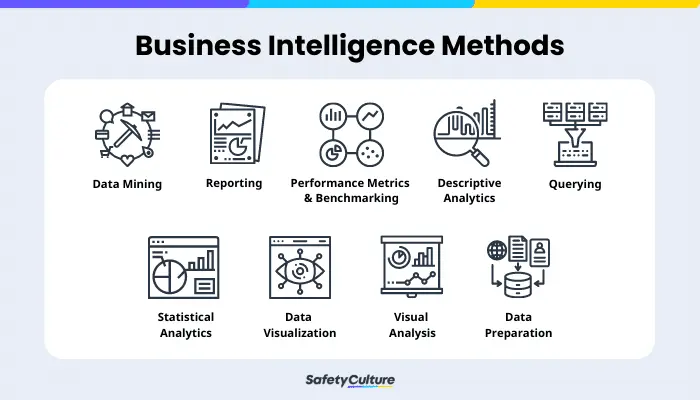What is Business Intelligence (BI)?
An umbrella term, business intelligence is a technology-driven process for transforming raw data into actionable insights. Businesses can gain a holistic view of their operations by collecting and using data from multiple sources. BI tools can also help companies track Key Performance Indicators (KPI) and predict future outcomes.
Traditional BI has roots in the 1960s as a method of sharing information across organizations. 1989 saw the introduction of the term “Business Intelligence” along with computer models for decision-making. These applications evolved into insights before becoming a distinct service offering from BI teams specializing in IT-reliant service solutions.
In recent years, BI has become increasingly commonplace as businesses of all sizes recognize its value. In an era when data generated by businesses continues to grow, BI will likely play an even more critical role in helping companies make sense of it all and make better decisions.
Benefits of Business Intelligence
An organization’s successful BI program provides a slew of business advantages.
Monitoring company performance daily allows C-suite executives and department managers to act quickly when challenges or opportunities arise. Analyzing consumer data can help marketers, salespeople, and customer service representatives succeed. It is possible to detect supply chain, manufacturing, and distribution bottlenecks before they cause significant financial damage to the company. HR leaders can better track employee output, labor costs, and other personnel data.
In general, the key benefits that BI solutions may provide to businesses include the ability to:
- Increase productivity and help make better decisions
- Optimize internal business processes
- Boost operational efficiency and productivity
- Analyze and fix any business problems
- Find out what business and market trends are emerging
- Come up with more robust business strategies
- Increase sales and bring in new revenue
- Gain an edge over competitors
Business Intelligence vs. Business Analytics
Business intelligence and business analytics are terms often used interchangeably, but they refer to two types of data analysis.
Business intelligence focuses on historical data and reporting, unlike business analytics, which analyzes data to make predictions about future conditions. Both approaches have strengths and weaknesses, but businesses that want to stay ahead of the competition must use both.
Business intelligence relies on past data to make decisions about the present and future. This approach is essential for understanding what has happened in the past and why it happened, but it can only take businesses so far. In today’s rapidly changing world, companies need to be able to anticipate future trends and adjust their strategies accordingly. It is where business analytics comes in.
Business analytics takes a forward-looking approach, using data to identify patterns and trends to help businesses make better decisions. This approach requires more work up front, but it can pay off in a big way in the long run. Companies can use business analytics to ensure they’re always ahead of the curve instead of playing catch-up.
Business intelligence and business analytics are essential for a business to remain competitive. Using both approaches together will give businesses the best chance of success in today’s ever-changing marketplace.
Categories of BI Analysis
There are three main kinds of BI analysis, each suited to a distinct set of requirements and uses. These are known as predictive analytics, descriptive analytics, and prescriptive analytics.
Predictive Analytics
Predictive analytics combines historical and real-time data with future projections for planning purposes. To predict future events, it uses statistical models to identify trends and patterns.
A few examples of the uses of this type of BI include marketing, fraud detection, and risk management.
Descriptive Analytics
The approach of descriptive analytics is to look for trends and connections in data using historical and current information. The goal is to understand better what has happened in the past and why it happened. Reporting and ad-hoc analysis are common uses of this type of BI.
Prescriptive Analytics
Prescriptive analytics processes all of the relevant data to answer the question, “what should my business do?” This type of BI uses optimization algorithms to identify the best possible course of action. Pricing, inventory management, and resource allocation often use this approach.
How Does Business Intelligence Work?
Businesses and organizations have concerns and objectives. To respond to these queries and track progress toward their goals, they must first collect data, analyze it, and choose which activities to take to achieve them.
Business systems provide raw data for analysis. Data is processed and stored in warehouses, the cloud, apps, and files. Business users can access the data after it’s stored, which begins the analysis process to solve company questions.
BI platforms also offer tools that turn data into charts or graphs. It can help present information to key stakeholders or decision-makers.
The Different BI Methods
Business intelligence is a broad term that encompasses the procedures and techniques for gathering, storing, and analyzing data from company operations or events to optimize performance. It is more than just a “specific thing.” A 360-degree view of a company provides a broader perspective on the business, allowing individuals to make more informed judgments.
Business intelligence has advanced in recent years, adding further procedures and actions to improve performance. The following are some examples of these processes:

- Data mining – Databases, statistics, and Machine Learning (ML) can be used to find patterns in big data sets.
- Reporting – Giving stakeholders information so they may draw conclusions and make decisions based on the findings.
- Performance metrics and benchmarking – Comparing current performance data to past performance information to assess progress against targets using custom dashboards.
- Descriptive analytics – Use preliminary data analysis to figure out what happened.
- Querying – BI pulls the data sets’ answers to answer data-specific queries.
- Statistical analysis – Using descriptive analytics findings and expanding them with statistics such as how this pattern emerged and why it occurred.
- Data visualization – Creating visual representations of data analysis such as charts, graphs, and histograms to make data more accessible.
- Visual analysis – Visual storytelling can help convey insights on the fly and keep the analysis flowing.
- Data preparation – Collecting data from different sources, figuring out the dimensions and measurements, and getting it ready for data analysis.
How Business Analytics, Data Analytics, and BI Collaborate to Provide Value for Your Company
Business intelligence includes both data and business analytics. However, it uses these things only as part of the whole process. BI helps business users understand what the data means. Data scientists study data in detail, using statistics and predictive analytics to see and predict future patterns.
Data analytics is a way to figure out why something happened and what might happen next. Business intelligence takes all the data from analytics and turns it into a language people can understand and use to make data-driven decisions. In short, businesses use data analytics as part of their larger business intelligence strategy.
BI can help answer specific questions and give you a quick overview of what you need to know. But companies can also use analytics to improve the questions they ask and how they learn from their data. Business analytics shouldn’t be a linear process. It is because answering one question will likely lead to follow-up questions and iteration.
Think of the process as a cycle of data access, discovery, exploration, and information sharing. It is called the cycle of analytics. This term explains how businesses use analytics to change their plans based on their learning.
Traditional BI and Modern BI: What’s the Difference?
In the past, business intelligence tools follow a traditional model. It was when the top people in a company decided what information they wanted, and the IT department created reports to give them that information. If someone had additional questions about the report, they would have to take their time and start over. As a result, reporting cycles became slow and inconvenient because people could not use current information to make data-driven decisions.
Traditional business intelligence is still used for routine reporting and answering static inquiries. In contrast, modern business intelligence is interactive and approachable. Today, IT departments are not the only ones who can manage access to data. With the right software, multiple levels of users can customize dashboards and create their reports. This way, they can answer their questions about the data.
Use Cases of Business Intelligence
There are many uses for business intelligence, and listed below are just a few examples.
Performance Reporting
A common use case for business intelligence is business performance reporting. It could involve tracking website traffic, conversion rates, or sales figures. The objective is to identify trends and patterns in the data so that you can decide how to improve your business.
As an example, let’s say you have an e-commerce site. You might use business intelligence to track your sales figures over time. You might notice that sales are higher on weekends than during the week. You could then use this information to make decisions about staffing, promotions, or product offerings.
Customer Segmentation
Another use case for business intelligence is customer segmentation. Using shared characteristics divides customers into groups. It can be helpful for targeted marketing or sales efforts.
For example, let’s say you run a clothing store. You might use business intelligence to segment your customers by age, gender, or location. You could then use this information to create targeted marketing campaigns. For example, you might send different emails to different segments of customers.
Fraud Detection
Using business intelligence, you can also detect fraud. It involves analyzing data to identify patterns that could indicate fraud. For example, you might look for abnormal spending patterns or instances of using the same credit card in various locations.
Fraud detection is crucial because it can help you protect your business from losses. It can also help you build trust with your customers by showing that you are taking steps to safeguard their information.
How to Develop a BI Strategy
A BI strategy is your road map to success. In the early phases, you’ll need to figure out how to utilize the data, who will have what roles, and what responsibilities will be assigned. At a high level, it may appear easy; nevertheless, beginning with business goals is critical for your success.
Here’s how to start from scratch and build a BI strategy:
- Know your company’s objectives and goals.
- Identify the major stakeholders.
- Choose a sponsor from among your significant stakeholders.
- Choose the BI platform and tools that are right for you.
- Create a BI team.
- Define your scope.
- Make preparations for your data infrastructure.
- Make a list of your objectives and a road map.
Digitize the way you Work
Empower your team with SafetyCulture to perform checks, train staff, report issues, and automate tasks with our digital platform.
Get Started for FreeDifferent BI Software and Systems
Business intelligence uses tools and software to help you gather, store, and analyze data. Some common examples include:
- Dashboards
- Visualizations
- Reporting
- Data mining
- ETL (extract-transfer-load —tools that import data from one data store into another)
- OLAP (online analytical processing)
The dashboards and visualizations are the most popular tools since they provide fast and easy-to-understand data summaries at the core of BI’s value proposition.




